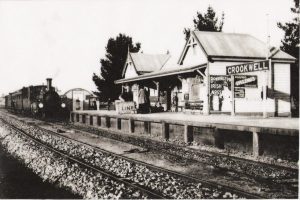
Transport of freight by road was slow and if rain occurred, the roads could be impassable and often were.
Therefore, farmers and settlers were at a great disadvantage in getting their produce quickly and cheaply to market, as road freight was not only slow but also expensive. Some produce needed to get to market quickly or it might spoil.
So it was that Crookwell and Taralga sought construction of a railway and joined the many other areas – both successful and otherwise – to seek rail communication.
A big problem in those early days, like today, is having enough money available.
Here then is the story of the building of the line to Crookwell.
Brief History of Goulburn
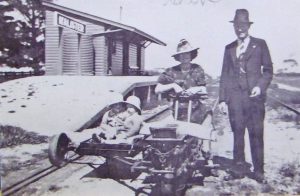
Many years elapsed and in 1818 Hamilton Hume and John Meehan passed through the site of the future city, followed by Governor Macquarie in 1820 and John Oxley two days later. Meehan named the Goulburn Plains after the Secretary of State for the Colonies.
In 1828 a few allotments were surveyed for the township and the following year a more extensive subdivision was approved.
Governor Bourke selected another site in 1832 and the new township of Goulburn was gazetted in 1833. However, building had already begun on the original site, which was to become North Goulburn. Goulburn was a garrison town for many years, and a convict road gang, based at the Towrang Stockade built the south road.
In the early 1820’s wheat was grown in the area but decreased in importance as more productive wheat areas further west developed. Stock and wool are now important activities having taken over in the 1860’s.
The town developed with the free settlers and Goulburn produce supplied the needs of developing places further south and became the main market for their produce. The railway arrived in 1869 and the town was the southern terminus until 1875.
The population had risen to about 23,000 people by 1978. Goulburn is 2074 feet above sea level and the annual rainfall is about 25 inches.
Early History of Crookwell
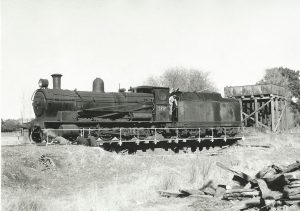
The general area was first explored by Dr Charles Throsby, who with three whites and three aboriginals traversed the country between the Southern Highlands and the Bathurst Plains in 1819. On 4th May 1819, Throsby passed close to where Taralga now lies, about 24 miles east of Crookwell, now lies. Surveyor Meehan was next to explore the area and passed through Woodhouselee and camped at Grabben Gullen overnight on 24 April 1820. His camp was only 7 miles south of Crookwell.
Squatters soon followed these early pathfinders to take up farms in the area and by the late 1820’s Crookwell River was named, although the origin of the name is somewhat uncertain. Early land grants were to Thomas Bray and Francis Oakes.
The early name of the town or town area was Kiama or Kyama. James Gormly indicated this in his notes of the time and that Crookwell was known as Oak’s Station in 1843. No houses existed at that time. Early maps of the time (about 1848) showed Sir Thomas Mitchell had a property ‘Crookwall’ on the Abercrombie River and Kiama was shown as a village reserve. In 1851 gold was first discovered in the area and of course encouraged bushrangers, including Ben Hall. However, little gold was found and the diggings were soon mined out.
Up to 1860 wheat growing had become an important industry in the area. Early farmers used potatoes to help break up the land for wheat and then rotated their crop with oats and barley.
A map was prepared in 1860 for Surveyor Armstrong who was authorised to lay out a village. The area was from Crookwell River, across the flat to some hills nearby. Close by the site on a river bend was Horatio Robert’s inn, built by him in the 1850’s and which was unfortunately demolished in the 1960’s. Thomas Wade was the occupier of land on the hill eventually taken in by the town.
At this time – In the 1850’s – a few more huts were added and the site was known as Kiama. Armstrong filed his report, having surveyed the town on 13th August 1860 and stated that it was appropriate “that the town should be called Crookwell”. He gave no reasons why he chose the name.
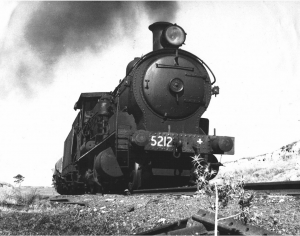
A police station and courthouse was asked for in 1869 as the population was nearing 1000 for the district of five miles around the town. However, nothing came of the request until a robbery at Pejar caused further demands to be made for police.
Tenders were called in August 1874 for a Court House but it was not completed until February 1878. However, the courtroom was found to be too small and the ceiling was damaged by snow in September 1878 and caused the building to be flooded. Alterations were made to the building in 1881 but even before this was completed, the building was found to be inadequate.
The roads at this time were particularly bad and in wet weather they were virtually impassable to teamsters. Around 1875 coach services were running between Goulburn and Crookwell. The journey in daylight ran once every fortnight. Fares were 15 shillings single and £1 five shillings return. The journey over hilly terrain would take most of the day to cover 28 miles. Passengers were required to dismount from the coach when the steeper hills were encountered.
As production of wool, flour and wheat developed, teamsters were required to get this freight to market and a railhead. Large teams of bullocks were necessary to haul the heavily loaded vehicles to Goulburn. Stock for slaughter was limited, because of the necessity to drive the animals to Goulburn.
Railway Proposals
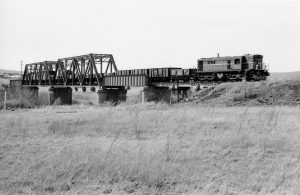
The approval for a line from Goulburn to Crookwell was, like many other branch lines, obtained only after much deliberation and fact finding. However, the line to Crookwell was obtained perhaps with more controversy than most, particularly with a number of experts having a variety of opinions as to how the line should be constructed, from where and at what cost.
As early as 1870 and up to 1880, the mention of a railway to Crookwell came to be mentioned in local meetings but it does not seem to be until January 1881 that a firm proposal was made. Messrs W.Holborow and P.Meyers ‘initiated a memorial’ which was presented to the Minister for Works, Mr. John Lackey. The scheme suggested building a tramway to Crookwell, which it was believed would serve 4,000 people, 60,000 acres under cultivation and 20,000 acres under pasture. It was suggested that this area would produce 500,000 bushels of wheat, 150,000 bushels of oats, 10,000 tons of potatoes, 4,000 tons of hay, 600 tons of wool, 140,000 sheep, 4,000 cattle and horses and 10,000 tons of sundries.
Memorialists suggested two routes from Crookwell. The first was via Cotta Walla and Woodhouselee, through Kingsdale and crossing the Wollondilly River at the old township. The second route was via Warn’s Springs, on to Gurrundah and on towards the Main Southern line on the Breadalbane plain. The latter passed through the finest land in the district.
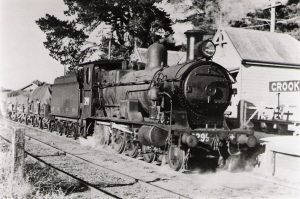
A Tramway Engineer was also deputed to examine and report on several routes and after this examination recommended a line from Crookwell via Gullen and Pomeroy to Breadalbane.
On 27th June 1881 the Commissioner for Railways informed Mr. P.J.Meyers, MLA, that the question of tramways to act as feeders to the railways would depend upon the result of the experiment then being tried on the Campbelltown to Camden Tramway. If that tramway proved a success then the Crookwell tramway proposal would receive full consideration.
On 10th August 1881, a deputation headed by Mr. M.Fitzpatrick, MLA for Yass Plains presented a memorial to the Minister, urging that a survey be made of the country between Crookwell, via Grabben Gullen to Breadalbane.
As two routes had been proposed, a “survey had better be made of both of them”, was the Ministerial response.
A new feature was introduced on 13th August 1881, when a petition was submitted by the inhabitants of Taralga and the neighbourhood also for a tramway from there to Goulburn. The engineer was therefore instructed to combine the two proposals and that officer reported upon two routes, one of which was to Crookwell with a branch to Taralga.
The engineer, on 7th September 1881, proposed two lines, one from Breadalbane via Grabben Gullen to Crookwell and the other from Goulburn to Taralga. The inhabitants of the eastern portion of the Burrowa electorate petitioned in September 1881, for the route from Breadalbane.
Mr William Teece MLA, wrote on 20th August 1882 asking that a line from Goulburn to Crookwell and Taralga might be included in the railway proposals and intimated that the most generally acceptable line was that from Goulburn via the Taralga crossing to Sugar Loaf, thence by branch lines to Crookwell and Taralga.
The Commissioner minuted on 30 September 1882, in anticipation of a deputation which was about to wait upon Mr Lackey Secretary for Works, that a line should be taken from Goulburn via Norwood, Ryhana and the Sugar Loaf to Taralga and that there should be a branch line to Crookwell.
As an alternative, he suggested that Crookwell might be reached from Breadalbane via Grabben Gullen and Pomeroy but in any case there should be a line from Goulburn to Taralga.

The Minister said that he thought a light railway would be better for the district and that he would shortly submit the survey reports to Cabinet. It seemed, however, that no definite action was taken and a considerable time elapsed before any further movement was made.
A further deputation later approached Mr. Wright, who was then Secretary for Works, to advocate for a line from Goulburn to Crookwell and Taralga and they submitted statistics and advised that cultivation was 60,000 acres and grazing land 940,000 acres. Sheep in the area totalled 426,000 and the calculation of the traffic that might be expected was presented.
We can only wonder about Mr. Wright’s thoughts when he was given these estimates for revenue. Such figures should have prompted immediate commencement of construction.
The deputation added that in the district there were 14 churches, 25 public schools and that the population and production were rapidly increasing.
The Minister stated that he was not aware that the district was so rich and populous and the deputation had presented a good case and as soon as the surveyors were available a trial survey should be made.
On 24th August 1883, a further deputation waited upon the Minister to ask that a railway might be taken from either Yarra or Breadalbane to Crookwell and not from Goulburn. The Minister promised to have an officer sent to examine the country and report as to the best route.
The deputation pointed out that both of the two routes indicated would be less expensive and shorter than the previous proposals, and would traverse rich country and better populated districts.
On 10th October 1883, Mr. Holborow complained that the surveyor had not been instructed to make a trial survey to Taralga, as was promised by the Minister. Mr. Wright instructed Mr. Whitton to have a survey made as soon as a man could be spared.
The same complaint was made by Mr. Teece made on 10th October 1883 and it was arranged that the surveyor should take up the Taralga route before leaving the district.
Mr M.Clancy wrote on 11th October 1883 and complained that the surveyor had not examined the Breadalbane route and asserted that this was an injustice to the people living on that route. Mr. Palmer reported that the instructions had been given to make a survey on this route.
Mr. Heydon, MLA, wrote to the Minister on 24th October 1883 reminding him of his promise to have all the rival routes surveyed, and to be guided in his selection by the relative merits of each. He was intimating that the Breadalbane route had not been inspected and requesting that the surveyor might be sent at once to carry out the survey.
Mr. James Chisholm also wrote to the Minister on 24th October 1883 with reference to a survey being carried out on a line to connect the Wheeo district with the main line at Yarra. He, his son and other proprietors, through whose land the survey was taken, were strongly opposed to the scheme and would claim heavy compensation if their land were taken.
He said if the Minister would look at the census returns and other statistics of the Wheeo, Gullen and Pomeroy districts, he would see that the line could not pay interest on cost, if indeed, it paid working expenses.
From a comparison of the respective statistics, it was far less likely to pay than the Camden Tramway. If the Government decided to build a line to the Crookwell district, it might be carried to Wheeo and that would meet all the requirements of the Wheeo district.
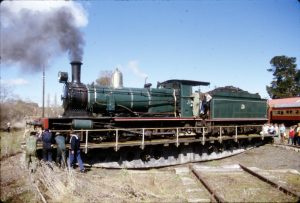
On 17th December 1883, Mr. Holborow again drew the Minister’s attention to the circumstances that the Taralga route had not been surveyed and this was again promised and that as soon as present surveys were completed, the survey would be put in hand.
On 17th December 1883 and 26th May 1884, Mr Heydon complained that the Breadalbane survey had not proceeded as promised by the Minister. The Minister, in response to these letters, on both occasions gave instructions for the surveys to be carried out.
A further petition was presented to the Minister in August 1884, requesting that Goulburn might be made the starting point for this line and that it might go to Tarlo and thence two independent lines to Crookwell and Taralga.
On 9th August 1884, a public meeting was held in Crookwell at which the districts claim to railway communication was strongly asserted. It was maintained that the ‘rapidly increasing population and the large produce of the soil and the low cost at which the works could be carried out, would make the line a paying one at the outset”. The final resolution carried at this meeting was to the effect that the Government is moved to adopt a line as soon as possible.
Mr. Frederic Shepherd wrote on 11th August 1884, that if the Government would take the line through Kingsdale for the limekilns, he and Mr Carr would give their land, required in Kingsdale, free.
On 22nd August 1884, another deputation waited upon Mr Wright to advocate the claims of Taralga and this proposal was to build a line from Goulburn via Roslyn with a branch 12 miles from the latter point to Taralga. The deputation also submitted statistical information.
Mr Dixon of the Technical College Laboratory made several analyses of the soil, pronouncing it to be exceptionally rich in the elements of fertility and second only to the Warrnambool and Clarence River soils.
In early October 1884, a public meeting was held in Goulburn and resolutions were carried in favour of making Goulburn the junction and affirmed the claims of Taralga.
On 23rd October 1884, yet another deputation waited upon Mr. Wright, who expressed himself as not being in favour of the Breadalbane route. He was undecided about the other routes and said the question would have to be fully considered.
Eight days later another deputation saw the Minister and they advocated the Yarra route, which they represented as the shortest, cheapest and the most convenient. The deputation suggested that, if the Goulburn route was selected, three bridges would have to be constructed and the length would be four miles longer (26 to 30) and some people on the Yarra route promised to give their land free.
The Minister intimated that he had in view the line that would serve the largest number of people and be the cheapest to build and work and the offer of land would have considerable weight with him.
On 7th November 1884, Mr. Wright received a further deputation in the interest of the Breadalbane-Grabben Gullen route and which, it was suggested, would pass through the best land and be the cheapest to construct. The Minister informed this deputation that he would select the best route and would be guided by the opinions of officers of his Department.
Mr Whitton reported that all the routes had been surveyed and the estimates prepared.
On 14th November 1884 the advocates of the Goulburn route forwarded a tracing of the district showing several routes and included Taralga so that it may also benefit. A statement was also supplied indicating the merits of the routes. This statement suggested that the Yarra route was unsuitable. It quoted the reasons that the (Main) Southern Railway already served the district, it would not be cheap, and it would serve only a few people and a small extent of the country. It could therefore not be expected to pay, and that a line from Goulburn would serve a larger population and benefit more country. It would also serve Taralga and the country beyond and a short branch to Taralga would pass through an area, which was quite populous and as fertile as Crookwell. This line would travel through extensive lime works and would serve the mining districts of Tuena, Peelwood and Junction Point.
January 1885 again saw another petition and this was from the residents of Argyle, Georgiana and King requesting that construction of the railway from Goulburn to Crookwell and Taralga be carried out.
Mr Palmer explained that when the Loan Estimates were prepared, the survey of the line was not complete and the estimate submitted was for the shortest route, that via Breadalbane. Therefore, if the Roslyn route were adopted, an additional sum would be needed.
On 3rd February 1885, Mr. Heydon again complained that the survey officer had not visited Gurrundah and Grabben Gullen in connection with the Breadalbane survey. Mr Deane explained that he had done all that was necessary and, if Breadalbane was adopted as the junction point, he would recommend the route via Gurrundah and Grabben Gullen and there could be no question of the superiority, on every ground, of the route from Goulburn via Roslyn.
It was not until the following November that a further ’memorial’ was received and this was made to Mr Lyne, who was the new Minister. This memorial was from the residents of Tuena and other places north of Taralga. It recommended the junction of a line to Taralga off the Crookwell line might be at the government reserve at the head of the Wollondilly River, 4 miles from the proposed junction on the Tuena Road. By using this proposal, an expensive bridge and steep grades would be avoided.
In May 1887, a further deputation, composed chiefly of Members of the House, waited upon Mr Sutherland and urged that the Goulburn-Crookwell line might be proceeded with. However, the Minister intimated that all he could do was to submit the information obtained and the prospects of traffic to cabinet for consideration.
In May 1889, Mr. Bruce Smith received a deputation from Goulburn residents and they advocated a deviation of the line through Kingsdale. This deviation was suggested because it would reduce costs and serve a larger population and moreover benefit large limekilns which, if they did not have railway facilities, would have to be closed. A request for survey was made. This deputation was informed that a surveyor had previously been sent to the area and he had made an unfavourable report.
A line had been permanently staked and had been reported upon by the Railways Commissioners in favourable terms and therefore any proposal to involve a deviation needed to be supported by substantial reasons. If there was any merit in the proposal then they had to prove it. Mr. Smith was prepared to have the deviation surveyed if they would give a guarantee to pay the cost of the survey in the event that the Government did not accept the deviation. A Mr. Quodling was instructed to furnish the cost but before anything could be done, the promoters of the deviation withdrew from their position.
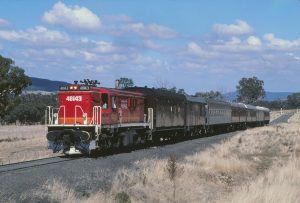
The matter was referred to a Parliamentary Standing Committee on Public Works, who formally commenced proceedings on 22nd August 1889. Evidence was taken in Sydney as well as in Goulburn and Crookwell. Joseph Barling, the Under Secretary for Public Works, was the first to give evidence. Barling advised that the single line be projected to be 33 miles 10 chains 38 links in length, with a probable cost of £198,000 or £5,984 per mile. Parliament had voted £259,500 for the cost of construction.
The line was described as leaving the Main Southern line about a mile on the Sydney side of Goulburn station at a point 133 miles 16 chains 62 links from Sydney (1889 measurement). The line would then pass near the new gaol and Police quarters to a crossing of the Wollondilly River. A northerly direction would then be taken for about 7 miles and thence the direction would alter to a north-westerly course towards Woodhouselee 151 miles from Sydney – then to a recently surveyed government township of McAlister 160 miles from Sydney. The line would then cross the head of the Wollondilly River and terminate at Crookwell, 166 miles 27 chains from Sydney. The chief item of cost on the line was to be the erection of a bridge over the Wollondilly River at Goulburn.
The route adopted for the survey was not the same one contemplated when the estimate was prepared for the Assembly in October 1884. The saving in through distance was achieved by starting the line at Goulburn instead of Breadalbane. This would serve a much larger settled district than would have been the case had the line commenced from Breadalbane and would allow for a later further extension to Taralga, situated to the north of McAlister.
On the same day, Henry Deane, the Acting Engineer-in-Chief for the Railways, also appeared before the Committee. Deane confirmed he had held his position from 1 June 1889 but had been a railway employee for 9½ years. He advised that Chief Engineer Whitton had sent him to the area of the proposed line in 1885. Deane stated that the proposed line was one he had recommended and that there had been two other proposals considered one from Yarra and one from Breadalbane.
Deane was questioned on the merit of his proposal, which he said was a little more expensive than the other two proposals but tapped a larger extent of good country and would serve the Taralga area as well as Crookwell. He also stated that the grades would not be steeper than those on the main line would and track would be laid with 60lb/yd rail and fenced with a seven-strand wire fence.
Other witnesses were called and on 4th September 1884 a Sectional Committee travelled to Goulburn where at 10am on 5th September their evidence taking was recommenced. At 11am the Sectional Committee left Goulburn for Crookwell by the permanently surveyed route.
The description of the line by the Sectional Committee was that after crossing the Wollondilly River the line proceeded in a northerly direction and passed through fairly good land for about 2 miles. For the next 5 miles the land was poor and indifferent, except in some patches in the valley and on the banks of creeks. The surveyed line was in close proximity to the road for the whole of the distance, crossing and re-crossing where necessary to ease curves or reduce the grades.
At the 141½-mile peg, at Forest Lodge, the line crossed the road for the purpose of making use of an ascending valley. It then ran across country in a north westerly direction for about 9 miles through poor land on which there were a few patches of fair land with a few settlers.
As the Committee reached the 144-mile peg, they found Mr Henry Hardy (Surveyor) taking sections and permanently staking the approved deviations of Mr Cummings. He was sworn in and evidence taken. Hardy had been in the area for 10 days with a view of reducing the grade from 1 in 40 to 1 in 50. It was observed that there were patches of timber growing that could be used for fencing or half round sleepers.
The line’s description continued and met the Goulburn to Laggan and Tuena Roads at the 150½-mile peg, hear Woodhouselee, ran nearly parallel and close by the road in a northerly direction for about 9 miles and passed through Woodhouselee at 151 miles. From this point the land was of good quality and considerable settlement existed on to Roslyn at 155¾ miles. Roslyn was proposed to be the Taralga line junction.
McAlister, at 159½ miles, was the next point and this was a Government township reserve and the nearest point on the line to Laggan, Peelwood and Tuena. The line then took a westerly direction and crossed the Great Dividing Range to Crookwell.
The Committee had left the staked line at McAlister and had continued along the road arriving at Crookwell at 6pm, where they observed that Crookwell seemed to be a prosperous town of about 1000 people and the natural centre of the district. At 8pm that same evening further evidence was taken at the Crookwell Court House. At 10am the next day evidence continued and the Committee held sittings until 9.15pm. Seventeen witnesses were questioned including farmers, bank managers, a hotelier and a builder, coming from various places around Crookwell. The Committee inspected the route leading into Crookwell and the site of the proposed station.
On 7th September 1884 the Committee, accompanied by guides, left Crookwell at 9.30am for Goulburn via Gullen, Pomeroy, Mummel and Yarra. After passing through Gullen and at about 7 miles from Crookwell, the suggested Breadalbane route branched off from the proposed Yarra route. For about 10 miles after leaving Crookwell the land was very good and more settlement was seen than in any 10 miles of the permanently surveyed route. The next 6 miles to Pomeroy, which was principally Crown land, was exceedingly poor and also difficult for railway construction.
At Pomeroy the proposed line entered a valley and for about 8 miles ran along the banks of the Wollondilly River through several large private estates, the land in the valley being exceedingly fertile. Within about a mile of Mummel the trail survey left the river and ran along Mr Chisholm’s estate, joining the Great southern Railway at Yarra. Except in two or three places, the Committee was in view of the Yarra route all the way from Crookwell to Yarra and from an elevated position on Mr Shepherd’s estate, which was about 9 miles from Crookwell; they were able to trace the Breadalbane route. After arriving at Yarra, the Committee took the Main Southern Road into Goulburn and arrived there about 4.30pm.
On 9th September 1884 the Committee inspected the permanently surveyed line from the Goulburn Station, through North Goulburn, the gaol and police reserves to the proposed railway bridge over the Wollondilly River.
At 10am on 10th September the Committee continued with examination of witnesses at the Goulburn Court House and concluded its inquiries at 5.30pm. The Committee returned to Sydney the following day.
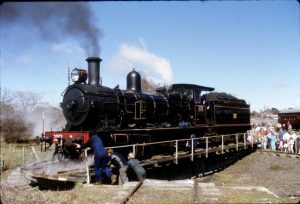
With the advent of railway construction, it was anticipated that the area under cultivation would double within two years.
Freeholds were 300 to 500 acres with areas of 30 to 80 acres under cultivation but with the heavy cost of 20s to 25s per ton to Goulburn being charged, there was a bar to increased production.
Several witnesses expressed an opinion that if railway communications were given, the people would, if it were necessary to make the line pay, be able and willing to pay a larger traffic rate than was then being charged on trunk lines. Some of the landowners holding land through which the line would pass had expressed their willingness to give the necessary land to the Government, free of cost.
In 1889 the Committee gave its seal of approval. The line would junction with the main line at Goulburn and run via Woodhouselee and Roslyn.
The necessary legislation was not passed until 22nd December 1899, due to the difficult economic conditions at the time.
Work commenced on the project in May 1900, under the control of the Public Works Dept. using day labour.
The first passenger trains were special excursions for the Crookwell Show on the 18th, 19th and 20th March, 1902.
Finally on 22nd April 1902 the line was handed over to the Railway Commissioners, and public services began with the first train arriving about 11am that day.
On 23rd February 1926 the Taralga branch line from Roslyn was opened and closed on 1st May, 1957, and the line was removed by 1959.
Proposed extensions over the years included in 1911 a possible extension from Crookwell to Bowning and on to Galong. In 1913 an extension from Crookwell to Cowra was proposed. Neither proposal came to fruition.
Cattle and sheep were the main source of traffic; however super-phosphate became the main source in later years.
During the war years Australian Iron and Steel opened an Iron-Ore mine at Back Creek near Crookwell, and a siding was constructed in association with the project. This resulted in two ore trains daily running to Port Kembla, probably the heaviest and most active traffic the line ever experienced. After the war this operation ceased.
A railmotor service ran in addition to the normal mixed loco hauled service, in the more prosperous days of the line, i.e. 1926-1944.
Following the passage of a steam hauled tour special in September 1985 the line fell into disuse.
Do you have any more information???
If you have any information to add please Contact Us.